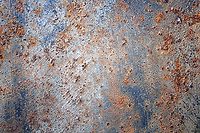New, Active Anti-Corrosion Pigments

Ferrinov high-performance industrial anti-corrosion pigments are produced from electric arc furnace (EAF) dust associated with carbon steel production. The flue dust is a mixture of complex (ferrites) and simple oxides containing trace amounts of heavy metals associated with different feedstocks of scrap metals with other iron admixtures. The bulk of the dust (>55%) yields a brown ferrite pigment of the franklinite (ZnFe2O4) type, while (12%) of the remaining reusable solid gives a black pigment of the magnetite (Fe3O4) type.
Ferrinov has developed a hydrometallurgical patent-pending process that eliminates the soluble heavy metals and segregates the ferrites into pigment grades used in heavy anti-corrosion coating applications. The company’s inhibitor pigment grades outperformed the best chromates and zinc phosphates, and the same pigment can replace the zinc dust in paint formulations. The pigments belong to the active category that protects the metal substrate by generating, under corrosive conditions, a passive barrier at the coating interface. Coating systems using Ferrinov pigments will resist blisters and creepage in or near the scribe line zone on a Q plate after more than 5000 hours in a salt spray cabinet. These pigments were found to be compatible with most widely used resin systems for primer and topcoats.
The company’s knowledge of the flue dust makes possible the selection of particular dust for specific grades, and the flexibility of its process allows Ferrinov to offer a large spectrum of ferrite grades. Ferrinov can commit to a constant quality supply for any particular grades and will back their specifications with certified analyses.
Ferrinov pigments are environmentally friendly products because they minimize the input of raw materials, recycle industrial waste and require a minimum amount of energy for their production. Therefore, the company’s process minimizes the emission of greenhouse gases. The Ferrinov pigments promote sustainable development and industrial ecology concepts.
For more information, visit www.ferrinov.com.
Technological Breakthrough Leads to Higher Performance
After 10 years of research and development, Ferrinov, located in Montreal (Quebec), has achieved a major technological breakthrough for many types of high-value infrastructure. New patented technology provides for the production of higher-performance anti-corrosion pigments that are economically and ecologically sounder as well as being compatible with all paint formulations. This technology uses a raw material entirely different from the other producing anti-corrosion pigments on the market.“Because their anti-corrosion properties are superior to any other pigment currently on the market, Ferrinov pigments allow for the production of much longer-lasting paints,” said company President Louis Archambault. “This leads to considerably reduced labour costs, lower downtime of production equipment and less frequent repainting of a vast array of infrastructure and high-value equipment. We are meeting the needs of a great number of our clients who were demanding a range of higher-performance anti-corrosion pigments.”
Environmentally Sound Technology
Taking a proactive environmental stance, Ferrinov devised a hydrometallurgical process to make pigments requiring only 15% of the energy needed by conventional technologies. Their production helps reduce greenhouse gases; the manufacture of a tonne of Ferrinov pigments avoids the emission of 4.5 tonnes of greenhouses gases, compared with a similar quantity of pigments produced by means of conventional technologies.The hydrometallurgical process developed by Ferrinov keeps substantial volumes of steel plant dust away from landfill sites by converting it to pigments. The process also avoids the mineral extraction and mining waste management engendered by the traditional production of pigments. Most of the conventional pyrometallurgical technologies now on the market were developed more than 100 years ago, in the late 19th century.
Exclusive Five-Year Agreement with Wonder Technology
Recently Ferrinov signed an exclusive five-year agreement with Wonder Technology Co. Ltd. for the distribution of some 6,000 tonnes of “green” pigments in the Chinese market.“This initial distribution agreement in China marks a milestone in Ferrinov’s development,” stated Archambault. “China represents about 30% of the world market for pigments used in industrial paint, estimated at 200,000 tonnes a year. This means that our growth outlook is astonishing. Within two years, we will have to decide on whether to build a plant in Asia.”
Innovative Solution for Quebec Ministry of Transport
In its DLC technical information bulletin of March 2009, the Quebec Ministry of Transport announced that “a major technological breakthrough may soon save a coat of paint on the steel structures (bridges, viaducts)”. The saving comes from a two- instead of three-coat system developed by paint manufacturer Prolux in collaboration with Ferrinov. The excellent performance of Prolux’s paint system in laboratory tests even exceeded the Ministry’s stringent standards for zinc-based paint systems, the DLC (Direction du laboratoire des chaussées) has concluded.Apart from reducing driver annoyance over infrastructure repairs, this would cut the labour costs of surface renewal and corrosion protection by about 25%. Numerous constraints at construction sites, particularly those related to the environment and traffic management, coupled with rising raw material prices, have constantly increased the cost of painting structures, points out the DLC. That’s why the Ministry of Transport has been laboratory testing certain two-coat paint systems. Among other benefits, these systems could reduce work site time, alleviate driver inconvenience and diminish overall project costs, specified the DLC.
To consult the DLC technical information bulletin of March 2009, visit www.mtq.gouv.qc.ca/portal/page/portal/Librairie/Publications/fr/reseau_routier/info_dlc/2009_2010/2009_03.pdf.
Ferrinov Inc., founded in 1998, has its head office in Montreal (Québec, Canada) and its plant in Sorel-Tracy (Québec, Canada). Both the company’s technology and its active anti-corrosion pigments are patent pending.
Looking for a reprint of this article?
From high-res PDFs to custom plaques, order your copy today!








